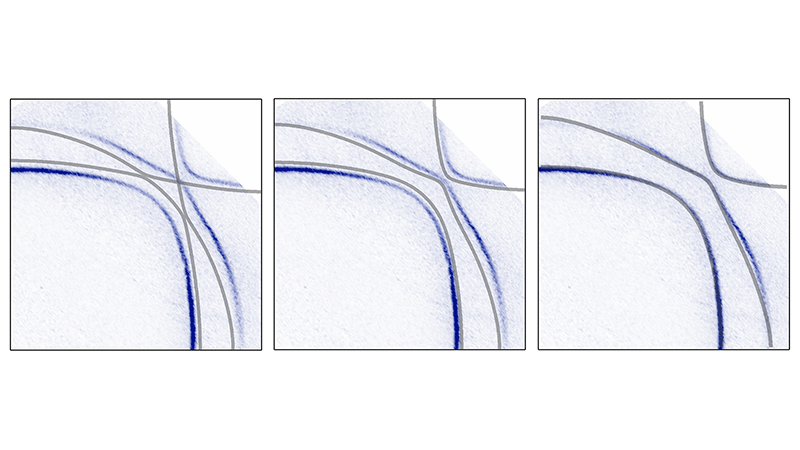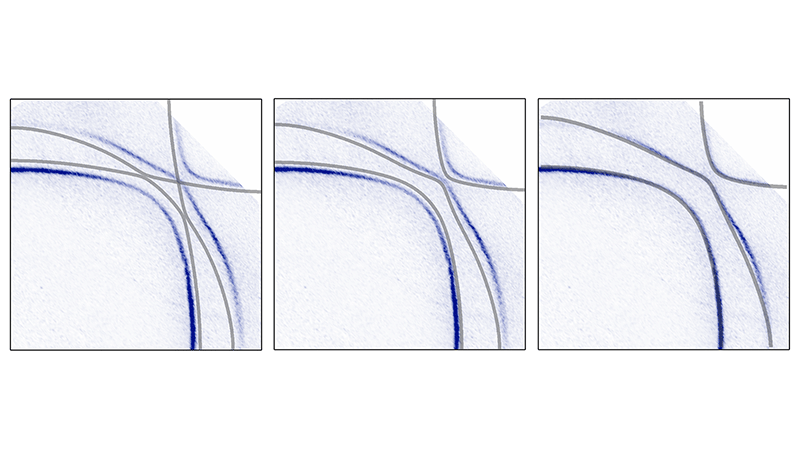A Laser-Sharp View of Electron Correlations
The photoelectric effect refers to the emission of electrons from a metal that is injected with light—a phenomenon that was discovered over 100 years ago and explained by Einstein. Today, the effect is the basis for a powerful experimental method known as angle-resolved photoemission spectroscopy (ARPES). This technique uses light to take a “picture” of a material’s electronic energy bands, the structure of which dictates many material properties. Researchers have steadily increased the resolution of these electron pictures by various means, including employing lasers as the light source. Now, using laser-based ARPES, Anna Tamai of the University of Geneva and colleagues provide an unprecedented test of a theory for materials in which electron correlations are strong [1]. The researchers studied the unconventional superconductor, Sr2RuO4, and determined that correlations enhance a parameter known as spin-orbit coupling (SOC) by a factor of 2—in agreement with the theoretical prediction. Their accurate measurement of SOC may also help physicists resolve a puzzle surrounding the superconducting state of Sr2RuO4.
Sr2RuO4 has been a font of interesting physics [2]. In 1994, experimentalists discovered that the material becomes superconducting at about 1.5 K. Theorists soon speculated that Sr2RuO4 was unlike other known superconductors. They also conjectured that its “Cooper pairs” of electrons, which carry the superconducting current, had a spin of 1 instead of a spin of 0 [3], indicating an unusual pairing mechanism. But the type of pairing has been an ongoing subject of debate. Support for the spin-1 picture comes from various early experiments, such as measurements of the superconducting phase, muon spin rotation, and the Kerr effect, whereas a recent nuclear magnetic resonance (NMR) experiment indicates spin-0 pairs [4]. The nature of the pairing is also relevant to the possibility that Sr2RuO4 is a topological superconductor, an exotic phase of interest for a robust form of quantum computing.
Sr2RuO4 is also attractive because its physics, including the pairing mechanism, is affected by interactions (or “correlations”) between the electrons. In fact, the material has become a model system for understanding these effects both experimentally and theoretically. A theory developed specifically for materials with strong correlations, known as dynamical mean-field theory (DMFT), predicts that electrons in Sr2RuO4 enhance the coupling between electron momentum and spin (spin-orbit coupling) [5, 6]. But this predicted enhancement has yet to be tested.
The work by Tamai and co-workers provides the best such test to date [1]. The team investigated electron correlations in Sr2RuO4 using ARPES to measure three energy bands near the Fermi energy. These bands are derived from three of the 4d orbitals of the ruthenium atoms, and their qualitative shape has been measured in previous ARPES experiments. What was harder to see until now was a theoretically predicted separation (in energy and momentum) between the bands. This band “splitting” occurs at the Fermi energy, and it is caused by SOC involving the 4d electrons.
The team determined the Fermi surface and the energy bands of Sr2RuO4 with unprecedented accuracy by using an 11-eV laser light source with an energy resolution of 3 meV and an angular resolution of 0.2°. Compared with earlier ARPES studies, the bands measured by Tamai et al. have narrower widths, making it easier to see the distortions induced by SOC. The group also took steps to suppress contributions from surface states, ensuring that their measured energy bands correspond to “bulk” electrons. (The experiments were performed at 5 K in the “normal” state of Sr2RuO4.)
The team determined the magnitude of the correlation-enhanced SOC in Sr2RuO4 experimentally by measuring the band splitting. The enhanced SOC is about twice as large as its “bare” value (no correlations), in agreement with the value calculated within DMFT. A separate, direct measurement of the correlation effects comes from comparing the measured bands with three calculations based on density-functional theory (DFT). This computational tool is more standard than DMFT, but it typically applies to materials without strong electron correlations. DFT calculations were performed without SOC, with bare SOC, and with an “effective” SOC that includes an enhancement from electron correlations (Fig. 1). The excellent agreement of the calculation (Fig. 1, right) with the ARPES data provides direct measurement of the enhanced SOC. These tests of DFT and DMFT give weight to the applicability of these approaches to Sr2RuO4 as well as to other materials with multiple d-electron orbitals, strong SOC, and strong electron correlations, such as the iron-based superconductors.
The “cleanliness” of the ARPES data also allowed the authors to confirm a fundamental assumption of DMFT that is related to the determination of so-called electron self-energies. These are shifts in energy that result from electron interactions, and they can have sizable effects on the energy bands. DMFT typically assumes the self-energies are momentum independent to simplify calculations. The researchers confirmed this “ansatz” by extracting self-energies from their measured bands, a result that provides further strength to the applicability of DMFT for Sr2RuO4.
Beyond testing theory, knowing the strength of the SOC is of interest for understanding superconductivity in Sr2RuO4—a far from settled topic. Strong SOC could substantially mix the spin-0 and spin-1 states of the Cooper pairs. Figuring out whether the SOC is sufficiently strong for this mixing to occur will require additional calculations [7]. But this step is worth making as physicists try to reconcile the new NMR data [4], which suggest spin-0 Cooper pairs, with older measurements, which support spin-1 pairs [2].
This research is published in Physical Review X.
References
- A. Tamai et al., “High-resolution photoemission on Sr2RuO4 reveals correlation-enhanced effective spin-orbit coupling and dominantly local self-energies,” Phys. Rev. X 9, 021048 (2019).
- A. P. Mackenzie and Y. Maeno, “The superconductivity of Sr2RuO4and the physics of spin-triplet pairing,” Rev. Mod. Phys. 75, 657 (2003).
- T. M. Rice and M. Sigrist, “Sr2RuO4: An electronic analogue of 3He?,” J. Phys. Condens. Matter 7, L643 (1995).
- A. Pustogow et al., “Pronounced drop of 17O NMR Knight shift in superconducting state of Sr2RuO4,” arXiv:1904.00047.
- G. Zhang et al., “Fermi Surface of Sr2RuO4: Spin-orbit and anisotropic Coulomb interaction effects,” Phys. Rev. Lett. 116, 106402 (2016).
- M. Kim et al., “Spin-orbit coupling and electronic correlations in Sr2RuO4,” Phys. Rev. Lett. 120, 126401 (2018).
- Q. H. Wang, C. Platt, Y. Yang, C. Honerkamp, F. C. Zhang, W. Hanke, T. M. Rice, and R. Thomale, “Theory of superconductivity in a three-orbital model of Sr2RuO4,” Europhys. Lett. 104, 17013 (2013).





